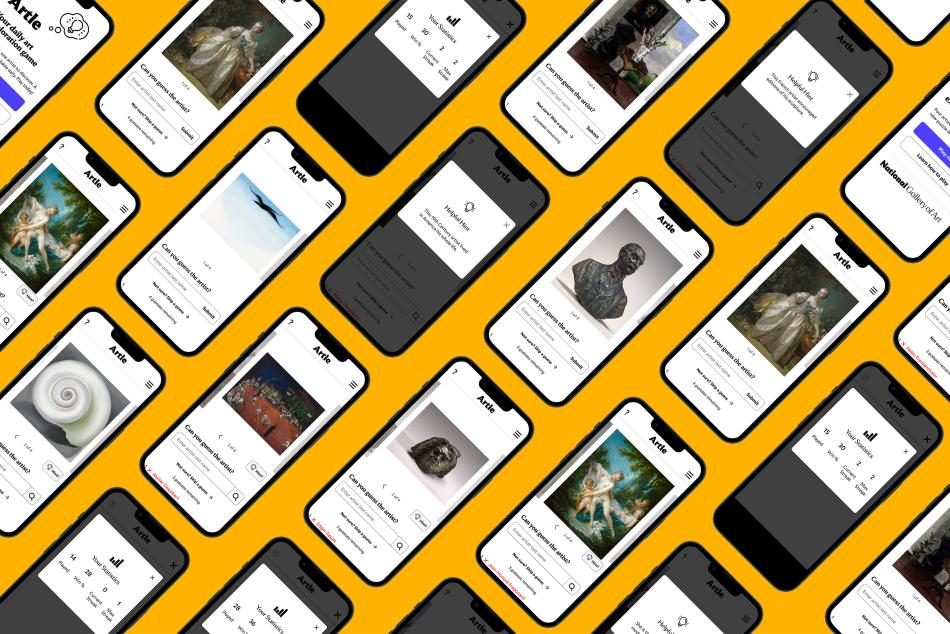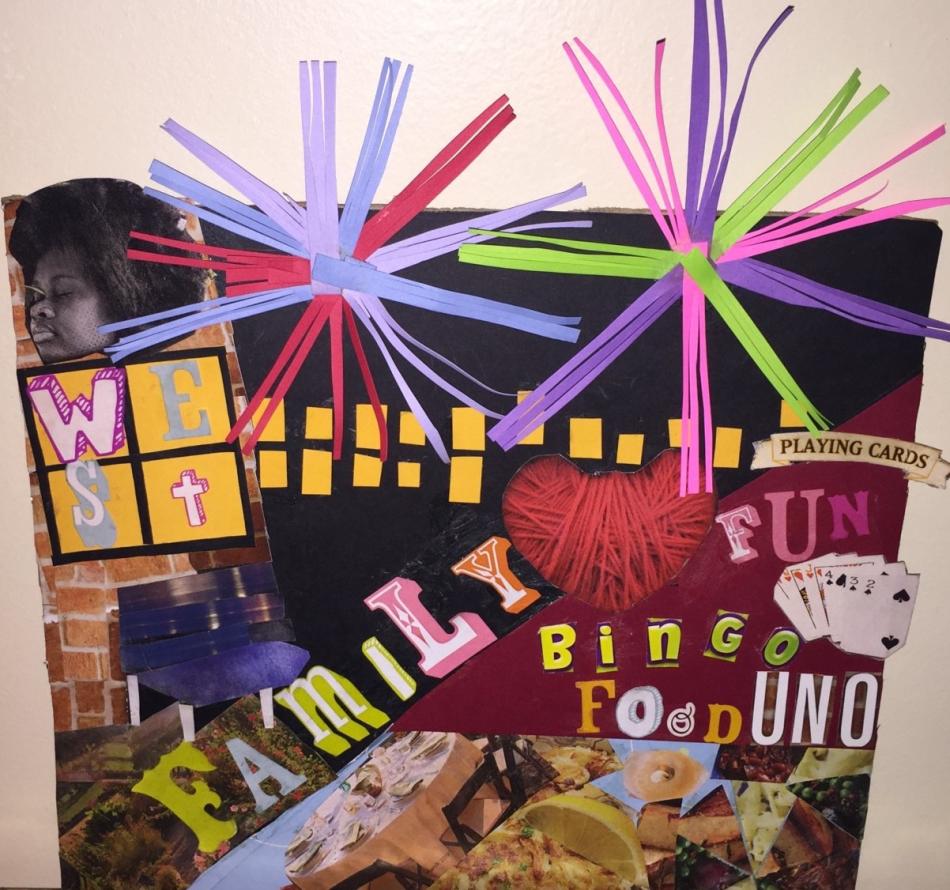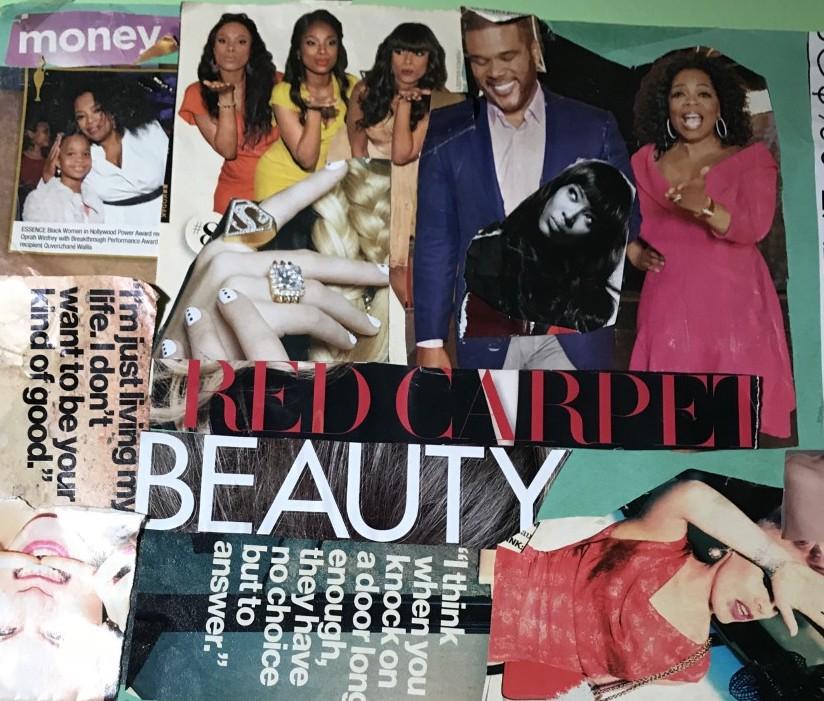When Romare Bearden was a little boy, his family moved from the countryside to the biggest city in America, New York. As a grown-up, he created collages inspired by his childhood—traveling south to visit his grandparents in North Carolina and the sights and sounds of New York City. Bearden started by collecting pieces of paper, including magazine illustrations, wallpaper, and hand-painted papers. He cut them into shapes and glued them onto a large piece of canvas, layering the pieces to make his picture. Bearden described his technique as “collage painting” because he often painted on top of the collaged papers.

Language
Look
What is the first thing you see when you look at this work of art? Why do you think it caught your attention?
How many people can you count in this picture? Describe what they are doing.
What colors do you see? Where else does that color appear? Find other colors and patterns that repeat throughout the picture.
What are the man and woman watching? What do you think they might be thinking? (To help children think through this question, draw a speech bubble on a printed version of the image and fill in what each person might be saying.)
Imagine yourself inside this scene: What sounds might you hear? What might you smell?
How do you think the artist made this work of art? What clues do you see that might help us understand how the work was made?
Create a story to go along with this scene. In your story, what might happen next?
Read
Islandborn (Spanish language version: Lola)
by Junot Díaz and Leo Espinosa
Lola's teacher asks students to draw a picture of where their families came from, but Lola was too young to remember the journey, so she asks her family and friends to help her fill in the picture.
My Hands Sing the Blues: Romare Bearden’s Childhood Journey
by Jeanne Walker Harvey and Elizabeth Zunon
This book tells the story of Bearden's daily life as he traveled from North Carolina to New York City.
Make: Create a collage
You Will Need
- Scissors
- Glue sticks
- Cardboard or tagboard
- Assorted papers, wallpaper sample books, wrapping paper, magazines, and/or postcards
- Personal photographs
First, think of a place that is special to you. What people, activities, sights, and sounds make that place special? Like Bearden, you will use your memories of everyday life in that place to help you make your artwork.
Next, gather photographs and postcards that remind you of that place. Collect patterned papers, such as wrapping paper or wallpaper, and look through magazines for pictures. Cut out patterns and colors from your papers, and then arrange and glue them on the cardboard to form the background.
Then, cut out details of people and objects from your personal photographs. Layer the pieces to create your scene. You can add more details on top with paint or markers.
Vocab Bank
- canvas
- collage
- pattern
Download
Art Tales: Coloring and Cut-Outs booklet (PDF, 3.5 MB)
Art Tales for Pre-K (PDF, 7.2 MB)
Primeros Pasos En El Arte (PDF, 7.5 MB)
Primeros Pasos En El Arte: Colorear y Recortes (PDF, 3.7 MB)
The Art of Romare Bearden teaching resource
(PDF, 2.5 MB)
An Eye for Art: Romare Bearden teaching resource (PDF, 9.4 MB)
Visit
Register for our Art Tales pre-K school tour
Submit Student Work
Send images of your students' projects that follow these activities - email [email protected]
You may also like

Educational Resource: Art Starters: Henri Rousseau
A lesson for preschool to kindergarten students about artist Henri Rousseau’s painting Tropical Forest with Monkeys. Students learn how to look at this painting, what you can read to learn more, how to create imaginary jungle, and a list of vocabulary terms related to this activity.

Educational Resource: Art Starters: Joseph Cornell
A lesson for preschool to kindergarten students about artist Joseph Cornell’s artwork Untitled (Medici Prince). Students learn how to look at this artwork, what you can read to learn more, how to build your own story box, and a list of vocabulary terms related to this activity.

Educational Resource: Art Starters: Louise Bourgeois
A lesson for preschool to kindergarten students about artist Louise Bourgeois' sculpture Spider. Students learn how to look at this sculpture, what you can read to learn more, how to create your own symbolic sculpture, and a list of vocabulary terms related to this activity.




